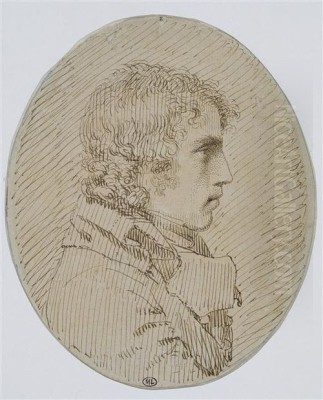
Pierre-Paul Prud'hon stands as a unique and compelling figure in the history of French art. Active during a tumultuous period that spanned the final years of the Ancien Régime, the French Revolution, the Napoleonic Empire, and the Bourbon Restoration, Prud'hon (1758-1823) carved a distinct path between the dominant artistic currents of his time: Neoclassicism and Romanticism. Neither strictly adhering to the severe linearity of Jacques-Louis David nor fully embracing the dramatic fervor of later Romantics like Théodore Géricault or Eugène Delacroix, Prud'hon cultivated a style characterized by its grace, subtlety, and profound sensitivity to light and shadow. He is celebrated for his allegorical paintings, intimate portraits, and exquisite drawings, which possess a poetic, often melancholic, charm.
Early Life and Artistic Awakening in Burgundy
Pierre-Paul Prud'hon was born on April 4, 1758, in Cluny, a town in Burgundy, France, famed for its medieval abbey. He was the ninth child of Christophe Prud'hon, a stonemason. His humble origins did not preclude an early display of artistic talent. Recognizing his potential, the monks at the Abbey of Cluny provided him with initial encouragement and perhaps some rudimentary training. His formal artistic education began later in nearby Dijon.
In Dijon, Prud'hon enrolled at the city's School of Drawing, founded and directed by François Devosge. Devosge, a painter and sculptor himself, became a crucial figure in Prud'hon's early development. He recognized the young artist's exceptional abilities, providing him with rigorous training and mentorship. Devosge's support extended beyond the classroom; he played an instrumental role in securing financial assistance and encouragement for Prud'hon to pursue further studies in the artistic hub of Paris.
Parisian Studies and the Lure of Rome
Around 1780, Prud'hon made his way to Paris, eager to immerse himself in the capital's vibrant art scene. He continued his studies, briefly attending the prestigious Académie Royale de Peinture et de Sculpture, where he likely encountered the prevailing Neoclassical doctrines championed by artists like Jean-Baptiste Pierre, the director at the time. However, Prud'hon's temperament seemed less inclined towards the rigid academicism and historical grandeur favored by the leading Neoclassicists.
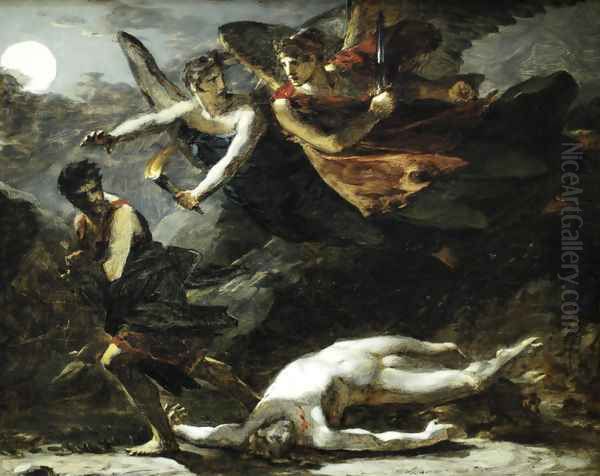
A pivotal moment came in 1784 when Prud'hon won the coveted Prix de Rome, a scholarship awarded by the Académie that allowed promising artists to study in Italy. This victory was not straightforward; he initially tied for the prize but ultimately secured it, enabling him to travel to Rome, the epicenter of classical antiquity and Renaissance mastery. His time in Italy, lasting approximately four years, proved profoundly influential and shaped the core of his artistic identity.
The Italian Influence: Light, Shadow, and Grace
Rome offered Prud'hon a wealth of inspiration far removed from the stricter Neoclassical tastes dominating Paris. While he undoubtedly studied classical sculpture and the works of High Renaissance masters like Raphael, he found himself particularly drawn to the painters who excelled in capturing subtle emotion and the sensuous play of light. He deeply admired the sfumato – the soft, hazy blending of tones – of Leonardo da Vinci, and the dramatic, often unsettling, chiaroscuro (contrast of light and dark) employed by Caravaggio.
However, the artist who arguably left the most indelible mark on Prud'hon was Antonio Allegri da Correggio, the High Renaissance painter from Parma. Correggio's mastery of soft, atmospheric light, his graceful and often sensual figures, and the tender emotionality of his work resonated deeply with Prud'hon's own sensibilities. He absorbed Correggio's techniques, particularly the delicate modeling of form through subtle gradations of light and shadow, which would become a hallmark of his mature style. During his time in Rome, he also formed connections with other artists, notably the renowned Neoclassical sculptor Antonio Canova, fostering an environment of artistic exchange.
Return to Revolutionary Paris
Prud'hon returned to Paris around 1788, just before the outbreak of the French Revolution in 1789. The ensuing years were a period of immense social and political upheaval, profoundly impacting the lives and careers of artists. Prud'hon, like many, initially showed sympathy for the revolutionary ideals of liberty and reform. He navigated these turbulent times by undertaking various commissions, including portraiture and, significantly, book illustration.
His delicate and refined drawing style found a suitable outlet in illustrating luxury editions of classical and contemporary texts for publishers like Pierre Didot. Notable among these projects were illustrations for works such as Bernardin de Saint-Pierre's Paul et Virginie and Longus's pastoral romance Daphnis et Chloé. These illustrations showcased his talent for conveying tender emotions and idyllic scenes, further honing his distinctive graphic style. He gradually built a reputation, distinct from the more politically charged art of David, for a gentler, more poetic vision.
The Napoleonic Era: Imperial Patronage and Masterpieces
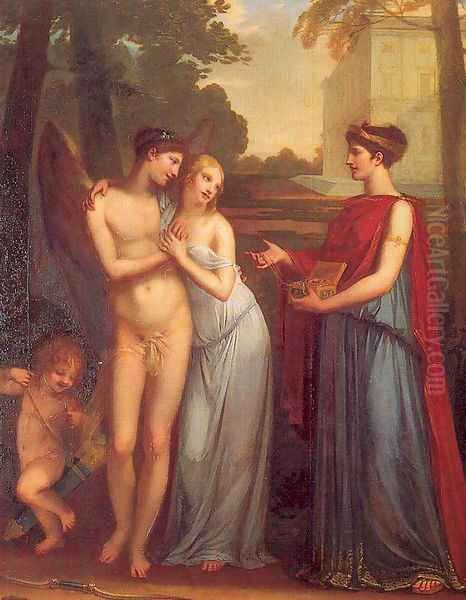
The rise of Napoleon Bonaparte brought a degree of stability and a new source of patronage. Prud'hon's elegant and less severe style appealed to the tastes of the new imperial court, particularly Empress Josephine. While never achieving the status of First Painter like David, Prud'hon received significant commissions and enjoyed the favor of the imperial family. He was appointed drawing master to the second Empress, Marie Louise, and was involved in designing decorations for imperial events and residences.
One of his most famous works from this period is the Portrait of Empress Josephine (1805). Depicting the Empress reclining gracefully in the lush gardens of Malmaison, the painting is remarkable for its intimacy and romantic atmosphere. It eschews the formality of traditional state portraiture, instead presenting Josephine with a melancholic sensitivity, enveloped in soft light and shadow, embodying Prud'hon's signature blend of elegance and emotion. He also created designs for furniture and interiors, such as the elaborate cradle for Napoleon's son, the King of Rome, and decorative schemes for Empress Marie Louise's apartments in the Tuileries Palace and for rooms in the Louvre.
Allegory and Official Acclaim
Beyond portraiture and design, Prud'hon excelled in allegorical painting, often imbuing classical themes with a unique psychological depth and atmospheric richness. His most celebrated work in this genre is Justice and Divine Vengeance Pursuing Crime (1808). Commissioned for the Criminal Court Room at the Palais de Justice in Paris, this powerful painting depicts a dramatic nocturnal scene where the winged figures of Justice and Vengeance swoop down upon a fleeing murderer carrying his victim.
The painting was a sensation at the Paris Salon of 1808. Critics and the public alike lauded its dramatic intensity, masterful handling of chiaroscuro, and emotional impact. The stark contrast between the illuminated figures of divine retribution and the shadowy realm of the crime creates a palpable sense of tension and moral weight. For this work, Napoleon himself awarded Prud'hon the Cross of the Legion of Honour, cementing his official recognition. Another significant allegory from the same year, Psyche Carried off by the Zephyrs, presents a gentler, more ethereal vision, showcasing his ability to render mythological subjects with delicate sensuality and dreamlike grace.
Prud'hon's Distinctive Style: Sfumato, Chiaroscuro, and Sensitivity
Prud'hon's artistic style is defined by its synthesis of classical grace and proto-Romantic feeling, achieved through a masterful command of light and form. His adoption of Leonardo's sfumato allowed him to model figures with exceptional softness, avoiding the hard outlines favored by strict Neoclassicists. Flesh appears supple and luminous, contours dissolve gently into shadow, creating an effect that is both realistic and idealized.
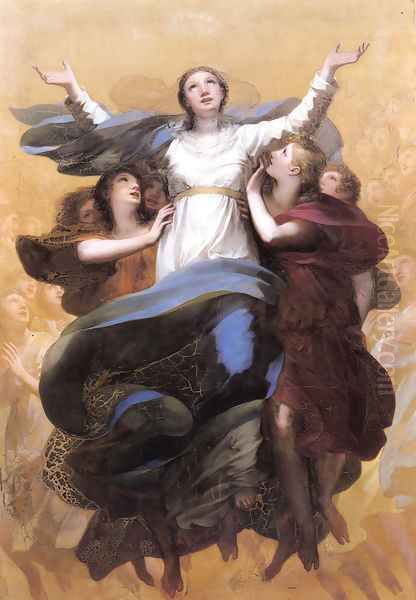
His use of chiaroscuro, inspired by Correggio and Caravaggio but adapted to his own ends, was less about stark, theatrical drama and more about creating atmosphere, mood, and psychological depth. Light in Prud'hon's work often seems gentle, caressing forms rather than harshly defining them, contributing to the poetic and sometimes melancholic quality of his paintings. He frequently worked out his compositions through numerous preparatory drawings, often using black and white chalk on blue or grey paper. These drawings, known as "académies," are highly prized for their exquisite refinement, subtle tonal gradations, and sheer beauty, standing as significant works of art in their own right.
His approach contrasted sharply with the dominant figures of his time. While he respected Jacques-Louis David, Prud'hon's emphasis on soft modeling, sensuousness, and atmospheric effects diverged significantly from David's heroic severity and emphasis on clear, didactic narratives. Compared to the cool precision and linear purity of Jean-Auguste-Dominique Ingres, Prud'hon's work appears warmer, more painterly, and more emotionally expressive. He shared perhaps a certain sensitivity with earlier artists like Jean-Baptiste Greuze, known for his sentimental genre scenes, but Prud'hon operated on a grander scale, tackling major allegorical and historical themes.
Constance Mayer: Collaboration, Love, and Tragedy
Prud'hon's personal life was marked by difficulty and, ultimately, profound tragedy, much of it intertwined with his relationship with the artist Constance Mayer (1775-1821). Mayer initially became Prud'hon's student, but their relationship evolved into a deep personal and professional partnership that lasted nearly two decades. Prud'hon was unhappily married to Jeanne Pennet, who suffered from mental instability and was eventually institutionalized. During this time, Mayer became his devoted companion, assistant, and collaborator, living in close proximity and managing his household.
Mayer was a talented painter in her own right, and the exact nature of their artistic collaboration is complex and debated by art historians. It is widely accepted that Mayer executed several paintings based on Prud'hon's designs and under his close supervision. Works such as The Happy Mother and Innocence Choosing Love over Wealth are often seen as products of this joint effort, bearing Prud'hon's stylistic imprint but likely painted largely by Mayer.
Their relationship, however, was fraught with the social constraints of the time. After Prud'hon's wife died in 1821, Mayer perhaps hoped for marriage, but Prud'hon, for reasons that remain unclear (perhaps age difference, social pressures, or personal inclination), hesitated or refused. Devastated, Constance Mayer tragically took her own life in Prud'hon's studio in May 1821.
Later Years, Final Works, and Death
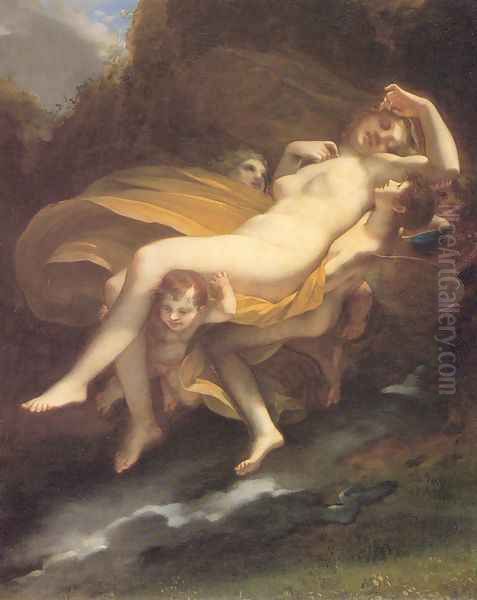
The suicide of Constance Mayer plunged Prud'hon into deep despair, casting a pall over his final years. Already prone to melancholy, he was reportedly inconsolable. His artistic production slowed considerably, though he did complete a few more works. Among his last significant paintings is Christ on the Cross (1822), commissioned for St. Denis Cathedral but now housed in the Louvre. This somber and moving depiction of the crucifixion is often interpreted as a reflection of the artist's own immense suffering and grief.
Though his reputation remained intact, Prud'hon largely withdrew from public life, burdened by sorrow and perhaps ill health. Pierre-Paul Prud'hon died in Paris on February 16, 1823, less than two years after Mayer's death. He was buried in the Père Lachaise Cemetery in Paris, where a monument featuring a bust by sculptor François Rude marks his grave, poignantly located near that of Constance Mayer.
Legacy and Influence: A Bridge Between Styles
Pierre-Paul Prud'hon occupies a significant, if sometimes overlooked, position in French art history. He serves as a crucial bridge between the waning dominance of Neoclassicism and the rise of Romanticism. His unique blend of classical elegance with heightened sensitivity, atmospheric effects, and emotional depth anticipated key elements of the Romantic movement.
His influence extended to the next generation of artists. The young Théodore Géricault, a pioneer of Romanticism, is known to have admired Prud'hon's work, particularly his powerful handling of form and dramatic light in works like Justice and Divine Vengeance. Eugène Delacroix, the leading figure of French Romantic painting, also held Prud'hon in high esteem, praising his mastery of chiaroscuro and his ability to convey profound feeling. Delacroix reportedly referred to Prud'hon as one of his "heroes" in painting.
Later artists and writers continued to recognize his unique qualities. Figures like the Barbizon painter Jean-François Millet and the influential critic and poet Charles Baudelaire admired the poetic realism and subtle emotional resonance of his art. Baudelaire, in particular, appreciated Prud'hon's departure from the perceived coldness of Neoclassicism. While contemporaries like Antoine-Jean Gros captured the epic grandeur of the Napoleonic era with more overt drama, Prud'hon offered a more introspective and lyrical counterpoint.
Conclusion: The Enduring Charm of Prud'hon
Pierre-Paul Prud'hon's legacy lies in his creation of a deeply personal and poetic visual language during an era of artistic transition. He skillfully navigated the currents of Neoclassicism and Romanticism, drawing inspiration from the Italian masters, particularly Correggio and Leonardo, to forge a style uniquely his own. Characterized by soft sfumato, evocative chiaroscuro, graceful figures, and a pervasive sense of tender melancholy, his paintings and drawings offer a world of subtle emotion and atmospheric beauty.
From his intimate portraits of Empress Josephine to his powerful allegories like Justice and Divine Vengeance Pursuing Crime, Prud'hon demonstrated a remarkable ability to infuse classical forms with psychological depth and romantic sensibility. Despite the profound personal tragedies that marked his later life, his dedication to his art remained steadfast. Though perhaps less famous than David or Delacroix, Pierre-Paul Prud'hon remains a vital figure, an artist whose delicate, luminous, and deeply human work continues to captivate viewers with its enduring charm and quiet power. His art stands as a testament to a unique vision that successfully bridged two distinct artistic worlds.